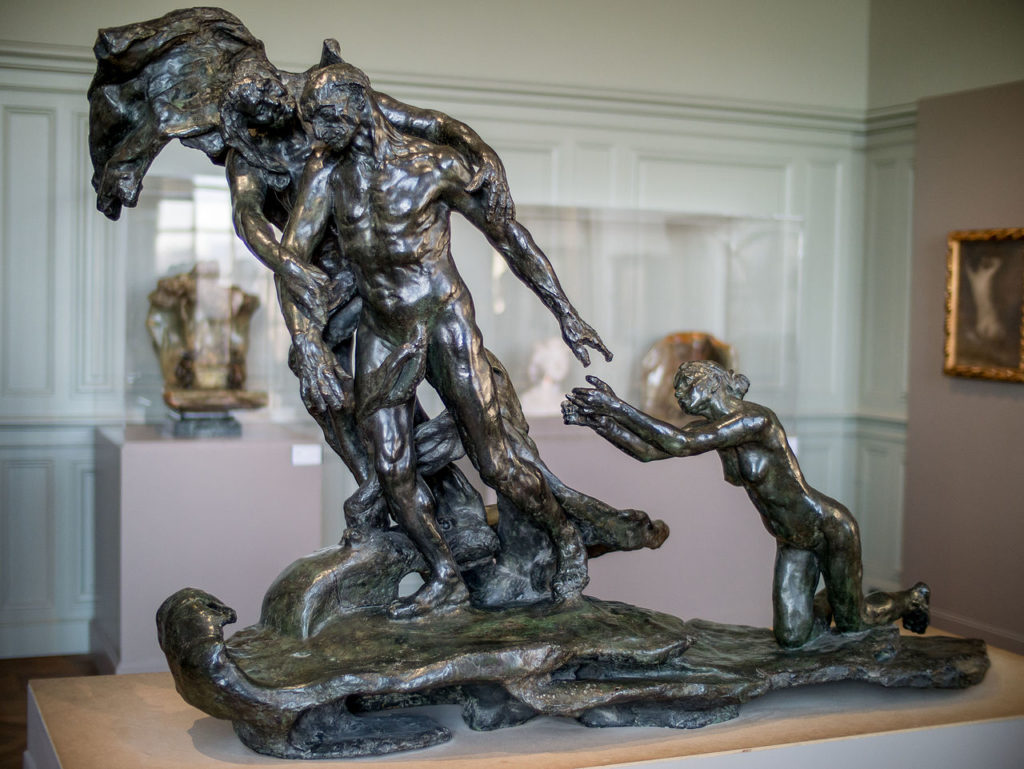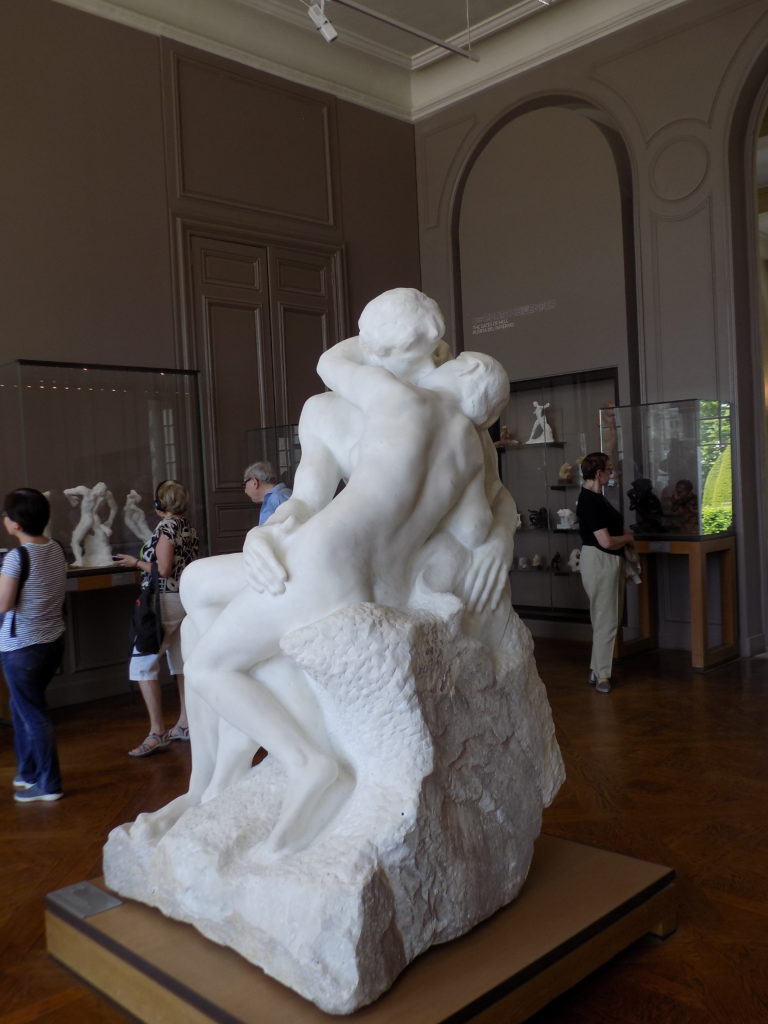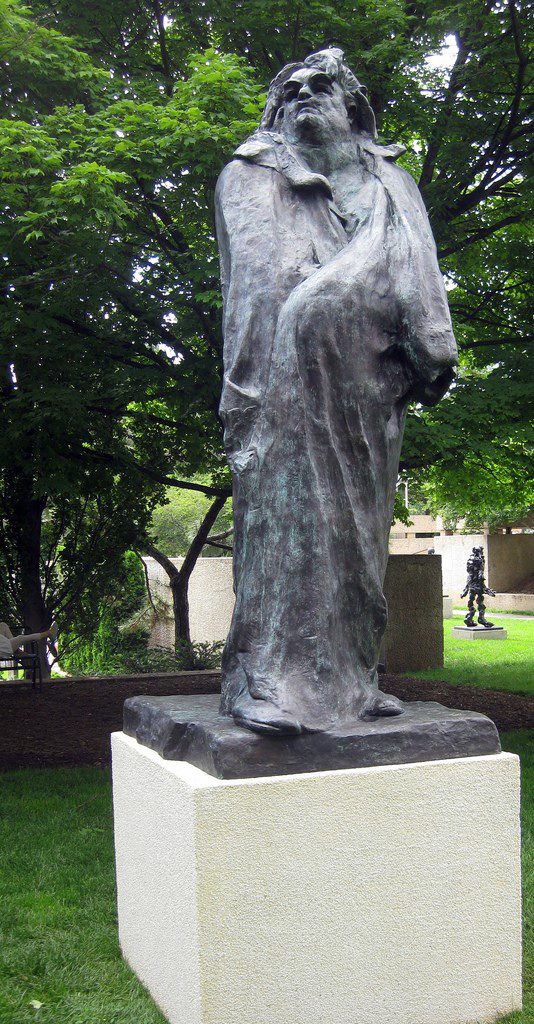Camille.
The great passionate affair I mentioned in the previous post began with the arrival at his studio of 20-year-old Camille Claudel. Claudel was an aspiring sculptor who had studied privately with Rodin’s friend Alfred Boucher because the École des Beaux-Arts did not admit women at that time. (Rodin took on many of Boucher’s students after his friend moved to Florence.)
In a short time, Claudel
(from Wikimedia.)
became not merely Rodin’s student but his muse, his inspiration, his model, his confidant, and his lover. Rodin continued living with Rose Beuret during this period and some think his refusal to leave her eventually led to the split between him and Claudel. However, Claudel is reported to have had an abortion in 1892 and this ended at least their physical affair although the two remained confidantes for several years thereafter.
While it’s plausible that they shared a continuing emotional attachment, a more likely reason the relationship continued is that Claudel’s talent led Rodin to support and promote one of his star pupils. One critic of the time called her, “A revolt against nature: a woman genius.” Her work has been described as having an urgency that suggests she was using the medium to not merely represent her models but to animate her emotions. The Paris Rodin Museum has a room dedicated to her work including this one titled L’age mûr (The Mature Age)
that is said to have infuriated Rodin because he viewed it as an allegory for the break in their relationship. The work was exhibited in plaster at the 1899 Salon and it was from this point forward that Rodin ended all of his support – financial and otherwise – for Claudel. (If you’re interested in her you can try to watch the 1988 film Camille Claudel directed by Bruno Nuytten and starring Isabel Adjani and Gerard Depardieu.)
Offended by the critics who had questioned his artistic integrity with The Age of Bronze, Rodin ceased creating life-sized sculptures adopting a slightly more exaggerated style for the rest of his career. Still, he didn’t avoid creating controversial art throughout his life as we will see.
The Gates of Hell.
The most recognizable long-standing achievement of the 1889 Paris World Fair is, of course, the Eiffel Tower. However, one of the other important events for that Expo was a joint exhibition by Rodin and Claude Monet held at the Gallery of Georges Petit. Rodin displayed 36 works almost all of which were figures from a monumental commission he’d been working on for nearly a decade that came to be called La Porte de l’Enfer (The Gates of Hell).
The work had been commissioned by Edmond Turquet the Under-Secretary of the Ministry of Fine Arts. Turquet had conferred legitimacy on the Age of Bronze when he purchased it from the 1877 Salon so he clearly viewed Rodin’s work favorably. The commission, given in 1880 and intended to serve as a monumental doorway for a planned museum of the decorative arts that never came to be, bestowed additional legitimacy on Rodin.
(Georges Petit is another interesting peripheral character to pop up in this narrative. He inherited the Galerie François Petit from his father. François had built its reputation not only from the direct sale of art but, according to Robert Jensen’s book Marketing Modernism in Fin-de-Siecle Europe, it provided services that “ran the gamut from certifying the authenticity of the object, to guiding it through the hazards of the marketplace, to establishing its provenance and enlisting critics and historians to situate the artist’s importance.”
Petit came into his inheritance in 1878 at the tender age of 22. He immediately became involved with the Impressionists though we should hesitate to describe that choice as having sprung from any great artistic insight. By that time, many of these painters had found markets for their work.
According to Wikipedia, “Petit made his private views into grand social occasions. He devised the series of Expositions internationales de Peinture, the first of which was held in 1882…These events attracted the likes of Claude Monet, Camille Pissarro, Pierre-Auguste Renoir, Auguste Rodin, Alfred Sisley and James McNeill Whistler.”)
The Kiss.
As part of his work on the Gates of Hell, Rodin used the story of the illicit relationship of Frances da Rimini and Paolo Malatesta portrayed in Dante’s Divine Comedy as one source of inspiration. (The amorous couple never made it onto the final version of the Gates of Hell.)
The first of several small versions (making small versions of sculptures before expanding them to a more monumental size was typical of Rodin’s working approach) appeared in 1882. Although a later version of The Kiss than the one commissioned by the French government would create quite a stir, the reactions to the one that appeared in the 1898 Salon were quite tame when compared to the controversy surrounding the Monument to Balzac.
A grand controversy.
In 1891, a Parisian organization of writers called the Société des Gens des Lettres commissioned the work to honor the novelist and playwright Honoré de Balzac. Rodin struggled for years trying to decide how best to depict his subject. In fact, he took so long that the Société threatened to take away the commission. Rodin’s goal was to portray Balzac in the midst of his creative process by depicting his “labor, courage and struggle.” When the work was finally displayed, not only did the Société reject it, it met with critical ridicule and parody.
Even as late as 1918, the critic C. R. Morey wrote in a statement simultaneously timely and prescient, “there may come a time, and doubtless will come a time, when it will not seem outre to represent a great novelist as a huge comic mask crowning a bathrobe, but even at the present day this statue impresses one as slang.” Of course, the work is now considered among Rodin’s masterpieces.
As for the parodies, they came mostly in regard to the strangely priapic bulge the writer seems to sport. Fortunately for art lovers, the castings of the Monument to Balzac have not suffered a fate similar to that of the sculpture that adorns the grave of Victor Noir.
The Kiss, was less controversial until Edward Perry Warren, an American who lived in East Sussex in southern England, contracted with Rodin to produce a full-sized replica of the sculpture in “the finest possible marble.” Calling himself a pagan and lover of antiquities, the contract stipulated at Warren’s insistence that “the genitals of the man must be complete.” He also indicated he hoped they would be sculpted prominently in the Classical Greek tradition rather than modestly hidden.
Interested in collecting his 20,000 franc fee, Rodin happily complied and depicted the male fully aroused. Warren, in what he might have thought was a gesture of public service, loaned the sculpture to the Lewes town hall during World War I. Unfortunately, (and perhaps predictably) puritanical locals were so offended by the perceived indecency of its nude protagonists, they thought it would incite lewd behavior among the soldiers. To remedy the situation, they surrounded it with a railing and covered it with a sheet. Today, the statue is part of the collection of the Tate Gallery.
In the final post, we’ll look at more of Rodin’s work, discuss his legacy, and, of course, wrap-up the day with what turned out to be our liveliest dinner in Paris.




